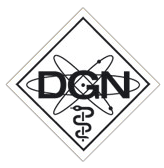
Abstracts der 53. DGN-Jahrestagung 2015
| Schilddrüse II - benigne 8:30 - 10:00 Niedersachsenhalle B |
|
| V162 The role of thyroid hormones in anxiety and depression R. Larisch1, S. Schulte1, G. Hildenbrand2, R. Hörmann1 1Klinikum Lüdenscheid, Nuklearmedizin, Lüdenscheid; 2Klinikum Lüdenscheid, Psychosomatik, Lüdenscheid | |
|
Ziel/Aim: Previous studies found an association between thyroid dysfunction and mood disorders like anxiety and depression. The aim of the present study was to examine the prevalence of these symptoms in an unselected sample of ambulatory patients and analyse their possible relationships with thyroid parameters.Methodik/Methods: We retrospectively evaluated the data of 1110 out-patients (79% female, mean age 56 ± 15 yrs) referred to our specialised thyroid diagnostic unit between January 2005 and June 2006. All subjects underwent both thyroid function testing and mood disorder screening using the ‘Hospital Anxiety and Depression Scale’ (HADS).Ergebnisse/Results: 48% of the subjects were euthyroid, 2% hypothyroid and 9% hyperthyroid. The rest had subclinical dysfunctions. Median HADS total score was 10 (interquartile range IQR 6-16). The median scores for the subscales of depression and anxiety were 7 (IQR 4-10) and 4 (IQR 1-7), respectively. 24% of subjects had pathological scores (≥ 11) in either one of the subscales and, thus, were regarded as suffering from a mood disorder. HADS score was higher in women than in men (p< 0.001) but did not differ between the euthyroid and other functional states. However, a more detailed analysis revealed a u-shaped relationship (generalized linear-quadratic model) between fT3 ranging from 1 to 10 pmol/l and HADS score (P=0.007) as well as anxiety (P<0.05) and depression (p<0.05) subscales, respectively. The proportion of patients with a mood disorder increased continuously (P=0.01) with both decreasing and increasing FT3 values from a level of 4 to 5 pmol/l where the fraction was lowest. No such relationship was found between mood and fT4 or TSH.Schlussfolgerungen/Conclusions: In conclusion, in a large unselected predominantly euthyroid sample we found a u-shaped relationship between the presence of anxiety/depression and serum fT3 levels, but no relationship of mood change with fT4 and TSH. This suggests that T3 rather than TSH or T4 mediates the mood changes which are associated with thyroid function. | |


